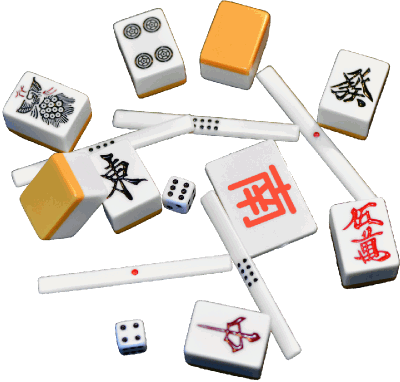This document is licensed under a Creative Commons Attribution-NonCommercial-ShareAlike 4.0 International License.
https://creativecommons.org/licenses/by-nc-sa/4.0/
Riichi Competition Rules (EMA 2016)Rules for Japanese Mahjong 2016 edition    | Riichi Competition Rules (EMA 2012)Rules for Japanese Mahjong    |
This document is licensed under a Creative Commons Attribution-NonCommercial-ShareAlike 4.0 International License. https://creativecommons.org/licenses/by-nc-sa/4.0/ | This document is licensed under a Creative Commons Attribution-NonCommercial-ShareAlike 4.0 International License. https://creativecommons.org/licenses/by-nc-sa/4.0/ |
PrefaceRiichi (modern Japanese mahjong) has been introduced independently in several European countries, and consequently slight differences in the rules exist across the continent. With the scheduling of the first European Riichi Championship in 2008, the need arose to standardize the riichi rules in the context of the European Mahjong Association. This booklet describes the standard riichi rules of the European Mahjong Association. Thanks go to Sjef Strik, Jenn Barr and Benjamin Boas for great help in shedding light on rule differences and practices and for invaluable advice. Some rules that have rooted in Europe are different in Japan, notably these three cases: 1. All Simples can only be claimed for a concealed hand. 2. When five counters are on the table, a two yaku minimum is invoked. 3. It is permissible to chow a tile and discard an identical tile from the hand. | PrefaceRiichi (modern Japanese mahjong) has been introduced independently in several European countries, and consequently slight differences in the rules exist across the continent. With the scheduling of the first European Riichi Championship in 2008, the need arose to standardize the riichi rules in the context of the European Mahjong Association. This booklet describes the standard riichi rules of the European Mahjong Association. Thanks go to Sjef Strik, Jenn Barr and Benjamin Boas for great help in shedding light on rule differences and practices and for invaluable advice. Some rules that have rooted in Europe are different in Japan, notably these three cases: 1. All Simples can only be claimed for a concealed hand. 2. When five counters are on the table, a two yaku minimum is invoked. 3. It is permissible to chow a tile and discard an identical tile from the hand. |
Tina Christensen, European Mahjong Association, May 14, 2008 | |
The rules have been revised in order to avoid ambiguities and scoring examples have been added for clarity. The uma has been increased, double yakuman has been omitted except for Big Four Winds and rules on etiquette and tournament play have been added. | The rules have been revised in order to avoid ambiguities and scoring examples have been added for clarity. The uma has been increased, double yakuman has been omitted except for Big Four Winds and rules on etiquette and tournament play have been added. |
Tina Christensen, European Mahjong Association, January 8, 2012 The rules have been revised in order to avoid ambiguities and comply more closely with current Japanese riichi rules and the World Riichi Championship rules. The main changes since the 2012 edition are listed here. • Red fives have been removed • Tanyao (All Simples) can be an open hand • Renho (Blessing of Man) is a mangan, not a yakuman • Dai suushii (Big Four Winds) is a yakuman, not a double yakuman • A hand with 13+ fan is scored as a sanbaiman, not a yakuman • The 3 second timing rule is removed • Swap-calling is not allowed • Temporary furiten ends when the player draws or claims a tile • Five counters implies two yaku: the rule is removed • Abortive draws are removed • Nagashi Mangan is removed • Uma is changed to 15,000/5,000/-5,000/-15,000 • Chombo penalty in a tournament is 20,000 points deduction after uma • Penalty rules are slightly more lenient in some cases Differences to World Championship Rules 2015 • Multiple winners are allowed • 4-30 is not rounded to mangan payment • Timing rules differ; EMA: pung takes predence over chow • Riichi bets at game end go to the winner This documents on is licensed under a Creative Commons Attribution-NonCommercial-ShareAlike 4.0 International License. It is available at http://mahjong-europe.org. Tina Christensen, European Mahjong Association, December 2015 |